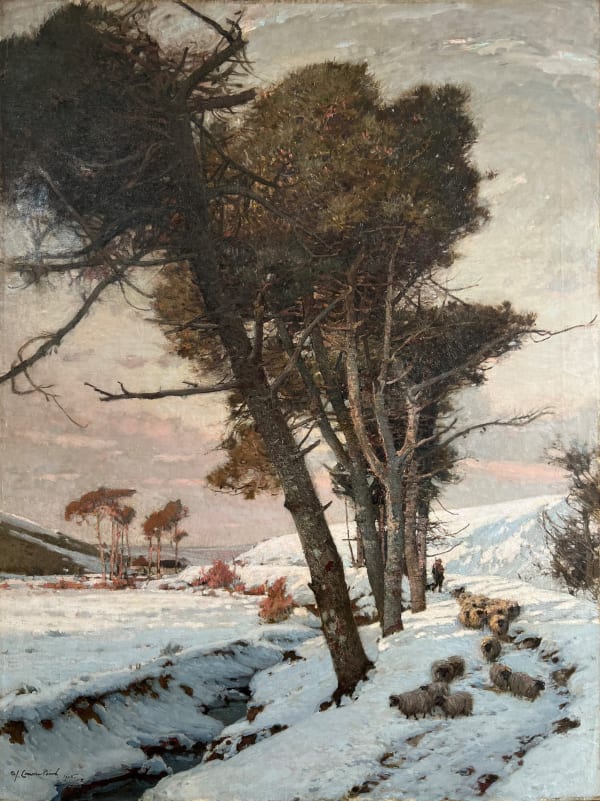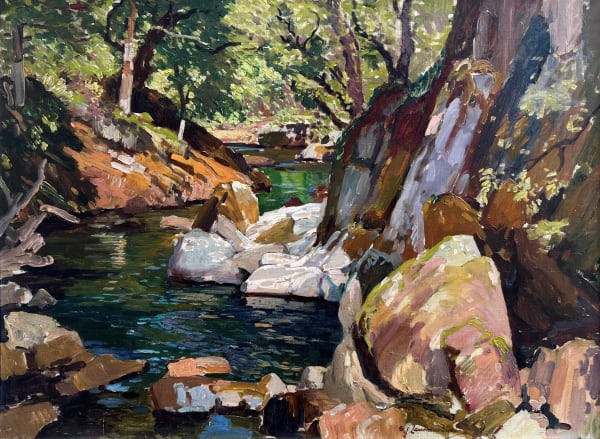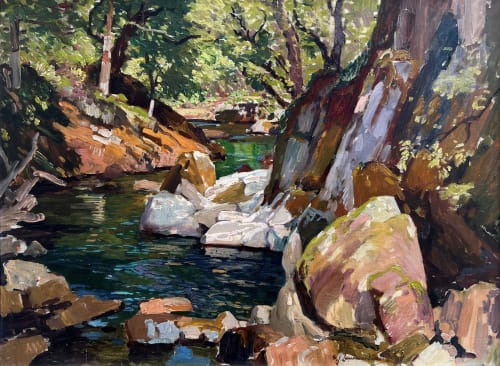Lamorna Birch paintings for sale
-
 Lamorna BirchWinter's Path, Roseworthy Valley, Camborne, 1905Oil on canvas102.2 x 76.7cm (40 ¼ x 30 ¼ ins.).
Lamorna BirchWinter's Path, Roseworthy Valley, Camborne, 1905Oil on canvas102.2 x 76.7cm (40 ¼ x 30 ¼ ins.).
Framed: 124.4 x 99cm (49 x 39 ins.).View full details -
 Lamorna BirchGrazing by the stream, 1901Oil on canvas46 x 30.5 cm (18 1/8 x 12 ins).
Lamorna BirchGrazing by the stream, 1901Oil on canvas46 x 30.5 cm (18 1/8 x 12 ins).
Framed: 61.5 x 46.3 cm (24 1/4 x 18 1/4 ins).View full details -
 Lamorna BirchOur Green ValleyOil on canvas46 x 61cm (18 1/8 x 24ins)
Lamorna BirchOur Green ValleyOil on canvas46 x 61cm (18 1/8 x 24ins)
Framed: 65.6 x 80.6cm (25.8 x 31.7ins)View full details
Samuel John Lamorna Birch was the founder and father figure of the colony of artists at Lamorna where he settled and worked for 60 years. He was a prolific artist painting over 20,000 paintings; enough to fill the Louvre 10 times over. A leading landscape artist of the first half of the twentieth century with 237 works exhibited at the Royal Academy and a host of wealthy patrons and collectors at home and abroad; in the mid-1920s it was estimated that there were more pictures by Birch in overseas galleries, than by any other living British artist.
Birch was born at Egremont, opposite the port of Liverpool on the Cheshire bank of the River Mersey on 7th June 1869. He was the son of a self-employed painter decorator and one of 9 children. Life for the Birch family was challenging as Samuel’s father struggled with work related respiratory problems and a shortage of suitable employment, ultimately prompting a family move to Manchester.
Samuel was 8 or 9 before an interest in art was apparent. His mother encouraged him with words that were to prove a portent, “Carry on like that my lad and who knows? One day you could become an RA.” Although many years later the then Lamorna Birch admitted he had thought ‘RA’ stood for Real Artist! Before he left school Birch had decided he would be an artist and by age 19 this ambition was already refined to landscape artist.
For health reasons, and with the help of a liberal and compassionate mill employer (for whom Birch produced designs on oil cloth and other milled substrates), the young Birch moved to Halton a few miles upstream from Lancaster on the River Lune. Here his dual passions for fly fishing combined with painting expeditions grew, as did his expanding base of patronage amongst wealthy Lancastrian industrialists and Victorian landed gentry. In time Birch heard of a certain Stanhope Forbes who, in far off Cornwall, was upsetting the art establishment with his ‘foreign’ approach to painting. Curious, Birch took the new railway line from the mill towns of Lancashire to the end of the line at Penzance. Upon arriving at Mounts Bay in 1889, Birch later recalled “Never could I have imagined such a place. There was so much richness in the colours of land, sea and sky and so much going on it was altogether too much to take in at once.”
Birch returned to Cornwall in 1890 and 91 and in 1892 left the mill for good choosing to settle in the countryside some miles to the west of Newlyn at Boleigh Farm; a choice which reflected his greater interest in the physical rather than social landscape of West Penwith. Sensibly the artist continued to cultivate his sales platform in Lancaster and the north making numerous trips back, often hosted by patrons only too happy to engage his services in capturing a favourite landscape and enjoying a little trout fishing with the by then highly adept Birch.
Birch enjoyed his Royal Academy debut in 1893 aged just 24. He showed at the RA without break from 1905 to 1954, some 237 pictures. And 350 works at the Royal Society of Painters in Watercolour in Conduit Street.
Despite his move some miles from Newlyn Birch kept in close contact with the Newlyn colony and father of the Newlyn School of Artists, Stanhope Forbes. Forbes was adamant that Birch should expand his artistic horizons and study on the continent, recommending the Atelier Colarossi in Paris. But before Birch departed Forbes also advised him to adopt the additional name Lamorna to avoid confusion with the Penzance painter Lionel Birch. Birch duly complied and left for Paris in December 1895 remaining there until July 1896. In Paris for the first time the artist adopted the signature SJ Lamorna Birch. He much admired the French Impressionists, Monet, Sisley, Pissarro and Courbet. Towards the end of his period in France Birch had the honour of exhibiting at the Paris Salon.
In 1902 Birch met and married Emily Vivian Houghton and moved into Flagstaff Cottage (purchasing the freehold 21 years later). Importantly for Birch, a nearby trout stream ran through the valley and his studio garden before spilling out into Lamorna Cove.
By now the young artist was a distinct looking country gent equally renown for his passions for fishing and landscape painting. An upright man he sported a pointed beard, tweed suits, plus fours, thick knitted stockings, brown brogues with an old tweed hat completing a striking appearance. Laura Knight observed that finer calves hadn’t been seen on any man.
Like his Newlyn mentor and peers, Birch was a plein air painter - he relished the physical challenge of anchoring his work to the ground with posts and ropes and meeting the challenge of strong winds and ever changing light. He painted largely in pure unmixed colour in order to preserve the freshness of the pigment and practised a technique of dragging colour from the sky down into the water of rivers, the sea, tree trunks and other landscape elements.
In 1905 Birch struck an arrangement with leading Bond Street dealers, Connell & Sons with a guaranteed minimum income of £200 per year. That same year he sold Winter (46 x 35 ins) to Manchester City Art Gallery which encouraged his development of his snow covered landscapes. In November 1906 Birch exhibited 123 watercolours under the title ‘Land of the West’. The show was a great success contributing to a very handsome income that year of £700 (equivalent to £105,000 in 2023).
Henry Scott Tuke and Henry Meynell Rheam were amongst Birch’s earliest painting companions in Lamorna, Tuke making the trip over from Falmouth. In 1907 Norman Garstin introduced Birch to Laura and Harold Knight. The Knights were part of a second generation of Newlyn School trained artists under the auspices of Stanhope Forbes. In 1909 the 3 artists established a London Base just off Piccadilly close to Burlington House (The Royal Academy) dividing their time between there and Cornwall. Other artists associated with the Lamorna group were Eleanor Waymouth, future husband Robert Morson Hughes and Dod Shaw (later Procter), Ernest Procter, Frank Gascogne Heath and Charles Simpson. These Forbes students initially painted at Lamorna as part of group tutorials but later worked there independently. Elizabeth Forbes was instrumental in the Newlyn School painting expeditions to Lamorna and a highly regarded friend of Lamorna Birch.
It wasn't until 1911 that Birch first made reference to a 'colony' in relaton to the collective of artists at Lamorna, referring to "the whole colony" in a letter to his wife. Another frequent visitor at that time, Alfred Munnings set up base temporarily at Lamorna that same year. Christopher Nevinson (the renowned war artists of WW1) visited Lamorna and Gluck (Hannah Gluckstein) arrived in the winter of 1914-15. She was always made most welcome at Flagstaff cottage but her bohemian appearance (sporting a pipe, plus fours and short cropped hair) rather shocked the West Penwith locals. But arguably the most notable 'Lamorna' artist was Laura Knight, who painted some of her, and the colony's best known and most sought after pictures; many of young woman sitting in the western sunshine upon the cliffs above Flagstaff Cottage.
Birch was an extremely sociable character striking up conversations wherever he went; a talent that he used to great professional effect in cultivating his base of wealthy patrons and public gallery curators. Laura Knight said of him: “No one I imagine ever made more friends. He had a heart as big as a bucket.” His business acumen and adept social skills enabled Birch to maintain a set of patron collectors and a healthy volume of sales during periods that were fallow for many other artists. Birch’s compassion for his peers often led him to press a few bank notes into a palm.
Birch was equally passionate about fly fishing as he was about painting. He fished and painted the Tweed, Tay, Dee, Usk and Deveron. As Alfred Munnings wrote of the artist; “when he was not painting he was fishing. And when he was not fishing he was painting.” His fly fishing expertise and the interplay between that and his subject matter was even noted in The Times: “He tied his own flies to perfection and to see him cast into the wind though a small opening in the bushes that fringed Lamorna steam was to witness a truly artistic performance …. His outdoor eye was especially sharp when painting water. He saw it with the understanding of both artist and fisherman.”
In the first half of the twentieth century Birch was something of titan of the Royal Academy. He served on the hanging and rejection committees, was elected Associate Member in 1926, a full Royal Academician by 1934 and in 1938, rejected calls to be appointed President of the Academy.
In 1927 Birch also helped to form the St Ives Society of Artists exhibiting at the opening in 1928. In 1936-37 Birch toured and exhibited in New Zealand and Australia. In 1946 he painted wedding presents for Princess Elizabeth on behalf of the people of Cornwall.
In 1952 Birch was elected president of the Newlyn Society of Artists. Born in the 1860s, quite remarkably SJ Lamorna Birch was interviewed on television by Richard Dimbleby in 1953. A year later he was taken ill in London and died at home on 7th January 1955. His last showing at the RA in summer 1954, composed of 6 works, was sold out by the end of the private viewing.
After his death his great friend Laura Knight wrote of the artist, “How bright was his art! How great was his heart!” A memorial exhibition was held in the Fine Art Society in New Bond Street in October 1955. His biographer Austin Wormleighton sums up the man, fly fisherman and landscape artist simply with; “Birch was driven not by greed for fame or power but by pursuit of excellence, and by the pure love of what he did.”
Just some of the galleries where works by Birch are held in collection are: Fine Art Society, Royal Society for Painters in Watercolour, Walker’s Gallery London, Royal Academy, Walker Art Gallery Liverpool, Royal Society of Artists Birmingham, Manchester City Art Gallery, Royal Society of British Artists, Royal Institute of Oil Painters and the Royal Scottish Academy.
Tom Cross; Painting the Warmth of the Sun. Lutterworth Press 1984
Austin Wormleighton; A Painter Laureate: Lamorna Birch and his circle. Sansom & Co. 1995
Painting at the Edge. British Coastal Art Colonies 1880-1930. Editor Laura Newton. Sansom & Co. 2005





